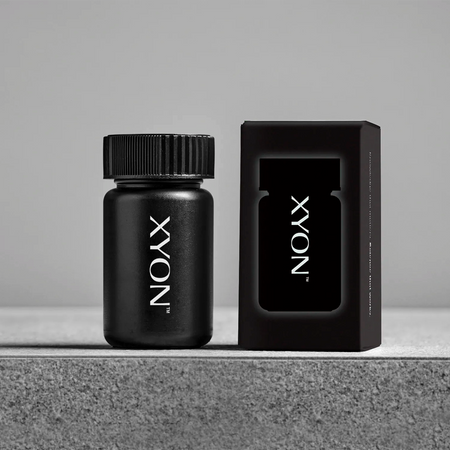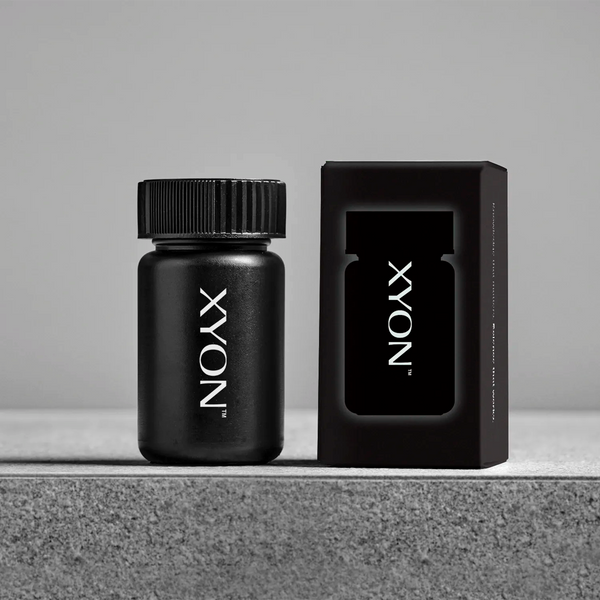Finasteride is by far the most prescribed hair loss medication for men and is generally safe to use but does have a risk of side effects. Whether or not it's safe is a question often asked when patients learn about it as an option for stopping hair loss. It’s FDA-approved at an oral dosage of 1 mg for the management of pattern hair loss and backed by decades of clinical research. However, with the increased availability of compounded (non-FDA-approved) forms of finasteride and a rise in reports of side effects associated with taking this medication, including potentially long-term side effects, it’s not surprising that patients want answers. It’s important for you to feel confident in your choice of treatment, so we encourage you to reach out to your doctor or another trusted healthcare provider for more information about any of the issues discussed here.


Not sure if you can take finasteride? Relax. We have you covered.
Every XYON intake is reviewed by a licensed doctor, so you can take your hair loss treatment with confidence.
What is finasteride? How does it work?
Finasteride is a type of drug called a 5-alpha reductase inhibitor (5-ARi). It works by blocking the effects of an enzyme called 5-alpha reductase that transforms testosterone into dihydrotestosterone (DHT). This causes DHT levels to decrease, which is a good thing when it comes to managing hair loss.
In men who are genetically predisposed to pattern hair loss, high levels of DHT can cause hair follicles to shrink. Over time, this process can progress to the point where hair follicles are unable to produce healthy hair, leading to the appearance of thinning or balding areas associated with pattern hair loss.
Whether you take finasteride as an oral tablet or a compounded topical formulation can have an impact on the amount of DHT reduction and the risk for potential side effects. We’ll take a closer look at why this is the case, below.
How safe is finasteride?
Finasteride (specifically the 1 mg oral tablet) is considered safe based on the rigorous standards set by the FDA that ensure that medications marketed to consumers in the United States (Health Canada for Canada) meet requirements for safety and efficacy. This does not mean that taking finasteride doesn’t have risks. However, clinicians and researchers have a reasonably good sense of what these risks are based on data from several decades' worth of drug trials. The most well-studied safety risks are those relating to sexual side effects, but increasingly there has been more data coming out about whether finasteride could pose risks to mental and psychological health.
Does finasteride cause sexual side effects?
Finasteride has been associated with sexual side effects, but they are still considered rare. The incidence is low, with one placebo-controlled study referencing a frequency of 2.1-3.8% (Mysore, 2012). However, these numbers vary widely depending on the study and the true incidence of sexual side effects is difficult to pin down.
One early randomized and placebo-controlled study on the use of oral finasteride to treat pattern hair loss reported that decreased sex drive and erectile dysfunction were the most common side effects (1.8% and 1.3% respectively, both compared to placebo) and noted that these side effects went away after discontinuing, or stopping the drug. The study was extended for five more years and researchers didn’t observe any new side effects during this time. They also noted that the incidence of side effects appeared to decrease after the first year of treatment (Shapiro and Kaufman, 2002).
In addition to these early studies, there are two large-scale and long-term studies of finasteride use that are notable. The first is a study published in 2011 that enrolled over 3000 participants and lasted 3.5 years. The overall incidence of adverse reactions was only 0.7% and the most reported adverse effects was a mild reduction in sex drive (Sato and Takeda, 2011).
Years later in 2019, a decade-long study involving 523 participants was published that reported no serious adverse events over the course of the study. Additionally, only 6.8% of participants recorded mild and temporary side effects. Of this 6.8%, 5.6% of participants reported decreased sex drive and 3% reported erectile dysfunction. These side effects were not serious enough to warrant stopping treatment, and all participants adhered to their treatment for the duration of the study (Yanagisawa et al., 2019). The findings from these trials support the idea that finasteride can be taken long-term without increasing the risk of side effects. This is important for many patients to be aware of because in most cases, hair loss treatment is a lifelong commitment that can involve taking medications like finasteride indefinitely to maintain hair growth.
Finasteride and psychological side effects
Finasteride use has been associated with an increased risk for mood disorders including depression and suicidal ideation, and in the past few years, reports of these kinds of side effects have increased. The FDA has updated safety labelling for oral finasteride to reflect these potential risks, and research into the biological mechanisms is ongoing. Considering the data that’s currently available, the relationship between finasteride and mood disorders remains controversial.
A large retrospective study looking at data from the World Health Organization’s global database of finasteride users found that the treatment was disproportionately associated with an increase in suicidality, depression and anxiety in males under the age of 45 (Nguyen et al, 2020). The data suggests that this group of people may be more vulnerable to adverse psychological side effects.
The association between mood disorders and 5-ARi use was further explored in a recent retrospective database analysis that examined 25,703 finasteride-treated and 355 dutasteride-treated patients (patients with a history of mood disorders or prior sexual dysfunction were excluded). The goal of this analysis was to further characterize this risk of mood disorders and determine whether there are specific demographic or clinical variables that contribute to this risk. Reassuringly, the analysis showed that there was no overall increase in the risk of developing mood disorders with either medication, but that older, Caucasian patients had a slightly higher risk compared to other age groups and backgrounds (Neubauer et al., 2025).
Where does that leave us? Given the seriousness of these side effects, we encourage patients who have a history of or active diagnosis of a mood disorder to share this information with their doctors when considering finasteride or dutasteride. We understand how complex hair loss is and the significant impact that it can have on mental health. Your doctor can work with you to ensure that your treatment delivers the results you’re looking for without compromising your well-being and comfort.
Is topical finasteride safer?
Potentially, but there are caveats. Available clinical data supports the idea that topical medications (including topical formulations of finasteride) generally have a lower risk of side effects. This is because applying medications directly to the skin (instead of swallowing tablets) likely results in less absorption of medications into the bloodstream. When less medication is absorbed, there is a smaller risk that it will affect parts of the body other than the scalp. While DHT lowering at the scalp can help stop the progression of hair loss, you don’t necessarily want this to happen everywhere in the body.
The first thing to be aware of when it comes to topical formulations of finasteride, is that these are not FDA-approved. They have not been tested by the regulatory agency for efficacy, safety, or quality. However, they may be prescribed by doctors in cases where the potential benefits outweigh the risks for a patient. This doesn’t mean that all topical formulations are inherently harmful, but that patients should be aware of the potential risks of their customized treatment.
The second thing to note is that not all topical formulations of finasteride perform the same way. Since they differ in the vehicle, or base that finasteride is mixed into, there can be significant differences in how quickly and how much finasteride is delivered. To give you an example, XYON’s patented technology, SiloxysSystem™ Gel, is designed for targeted and timed-released delivery of ingredients such as finasteride. These properties have been shown in clinical studies to help lower the amount of exposure to these ingredients and subsequently minimize effects on DHT levels in the body. However, not all topical bases have these features, so it’s important to do your research before moving forward with a consultation and prescription with any company. Ask about whether clinical data exists so you can make an informed decision about safety.
How does dosage impact side effect risk?
Dosage can have an impact on side effect risk by influencing the amount of exposure to a medication. When we talk about dosage, this refers to how much medication is in a dose and how much time there is between doses. High doses of medication with shorter time intervals can mean higher exposure, especially if a medication stays in the body for a long time (i.e., a long half-life) because it can have a cumulative effect.
The risk of systemic side effects generally increases with systemic exposure to medication. In other words, the more medication makes its way into your blood, the higher the likelihood of experiencing an unwanted or potentially serious reaction. Lowering the concentration, increasing the time between doses, or opting for alternate delivery formats designed to control the rate of delivery can lower exposure and potentially, the risk of side effects.
Can finasteride affect testosterone levels? Does finasteride affect fertility?
Some patients are worried about whether finasteride affects testosterone levels and fertility. Finasteride can temporarily increase circulating testosterone levels (remember the drug works by stopping testosterone from being converted into DHT), but like many other biological processes, these changes aren’t permanent. The body gradually adjusts to the presence of finasteride and responds by lowering testosterone production to return to baseline levels.
On the issue of fertility, there are some studies that have examined the effects of finasteride on sperm production and sperm quality. One study was conducted in men who were already struggling with infertility and taking finasteride and found that stopping the treatment resulted in a 11.6-fold increase in sperm count, but no significant improvements in sperm motility and morphology (shape) (Samplaski et al., 2013). This suggests that finasteride may be detrimental to fertility in men who are already struggling in this area. But what about men who aren’t faced with infertility challenges?
For most healthy men, finasteride is not expected to affect fertility. A 1999 study found that for healthy young males (aged 19-41), taking 1 mg of finasteride daily for 48 weeks (followed by 60 weeks off-drug) didn’t have significant effects on sperm concentration, total sperm per ejaculate, sperm motility or morphology (Overstreet et al., 1999). More recently, researchers examining the potential impact of 5-ARi use on fertility noted that any changes to sperm count or quality are probably insufficient to reduce fertility in men with normal semen levels prior to treatment (Drobnis and Nangia, 2017).
Can finasteride cause ED?
Finasteride can increase the risk of erectile dysfunction (ED), but the mechanisms behind how and why this happens have not been clearly defined. Amongst the sexual side effects related to the use of finasteride, ED is one of the more common ones. One placebo-controlled study reported that 3.4-15.8% of patients treated with finasteride experienced erectile dysfunction compared to 1.7-6.3% who received the placebo (Hirshburg et al., 2016).
On a physiological level, DHT is believed to play a role in the ability to have and maintain an erection by activating an enzyme involved in blood vessel function, but the difficulty is that we don’t know how low is too low for these DHT changes to have a negative effect on erectile function. Many patients can take finasteride without significant issues, so it’s possible that individual sensitivity to DHT changes is a factor that contributes to this risk. You can learn more about finasteride and erectile dysfunction by visiting our article.
Tips for using finasteride safely
-
Talk to a doctor.
If you’re concerned about the safety of finasteride, we recommend reaching out to a healthcare provider and voicing any worries you may have about potential side effects. Also remember that it’s important to share details like whether you’re trying for a baby soon, have a partner who’s currently pregnant or breastfeeding, or have a history of mental health challenges. The first two are important because accidental exposure to finasteride may pose a developmental risk to a fetus.
Some patients think that doctors are only responsible for writing prescriptions. The truth is that you should be able to have an ongoing relationship with your doctor and feel comfortable asking them for guidance if any bumps come up during your hair regrowth journey. This includes any worries you may have about side effects or concerns about your treatment progress. No one can force you to use a treatment if you’re not comfortable doing so.
-
Consider all your options for treating hair loss.
Oral finasteride is just one option for treating hair loss. Topical formulations of finasteride may be associated with less systemic exposure to finasteride, but because these compounded treatments are not regulated by the FDA, it’s important to weigh your options and consider the properties of the formulation you’re interested in. If a company or brand can provide clinical data to help support their claims, even better. Another treatment to consider is minoxidil, which uses a different mechanism to help promote hair growth. The ideal treatment is one that you’re comfortable with but is also appropriately matched for your stage of hair loss. Consulting a doctor is essential to getting started with the right solution.
-
Follow dosing instructions closely
There’s a lot of talk online about “microdosing” finasteride or adjusting how much and/or how frequently you take it without involving a doctor. We don’t recommend this. There's no way of knowing whether these alternate dosing regimens are safe, or if you’re taking enough treatment for the medication to be effective. Similarly, we don’t recommend crushing tablets and trying to make your town topical finasteride at home. In most cases, patients decide to microdose because they believe it offers better control over finasteride exposure and the possibility of side effects. A safer approach would be to consult with your doctor and see whether a lower dose or alternate dosing schedule would be appropriate and use the opportunity to voice any concerns about side effects.
So, can we draw any conclusions about whether finasteride is safe? Based on the data available, finasteride is an effective treatment for pattern hair loss that many people can take without issue. However, there are documented risks that patients need to be aware of including possible sexual side effects, mood disorders and the importance of safe handling if you’re planning on starting a family or have a partner who is currently pregnant or breastfeeding.
There are ways to mitigate or lower the risk of side effects. Topical formulations of finasteride, despite not being FDA-approved, could be a reasonable alternative for the right patient. When formulated carefully, they can help minimize absorption of finasteride into the bloodstream. Other options for treatment such as minoxidil or even surgical hair transplant exist. The best way to find out whether finasteride is right for you is to consult with a doctor or hair loss specialist. Remember, your medical history (including your mental health) can impact how you respond to treatment. Ready to take the next step?
FAQ
1. Is finasteride safe for long-term use?
Yes, finasteride is FDA-approved for pattern hair loss and is considered safe for most men when taken at the recommended 1 mg oral dosage. Decades of clinical research show risks are generally low, though side effects such as sexual dysfunction and mood changes can occur and should be discussed with a healthcare provider.
2. What are the most common side effects of finasteride?
The most frequently reported side effects of finasteride are decreased sex drive and erectile dysfunction, usually affecting a small percentage of users (typically 2-8%). Most side effects are mild and reversible after stopping treatment, but individuals may experience different sensitivities.
3. Does finasteride increase the risk of depression or mood disorders?
Some studies and updated FDA labelling note a possible increased risk of depression and suicidal thoughts, especially in younger men. However, research shows mixed results, and the overall link between finasteride and mood disorders remains inconclusive. Patients with a history of mental health issues should discuss these risks with their doctor.
4. Is topical finasteride safer than oral finasteride?
Topical finasteride formulations may reduce the risk of systemic side effects since less medication is absorbed into the bloodstream. However, these compounded topical forms are not FDA-approved, and efficacy and safety may vary between formulations. Clinical consultation is recommended before use.
5. Can finasteride affect fertility or testosterone levels?
Finasteride can temporarily increase testosterone levels by blocking its conversion to DHT, but this effect is not permanent. In healthy men, studies have found no significant impact on fertility parameters, but men already struggling with infertility should be cautious and consult their doctor.
References:
Drobnis, E. Z., & Nangia, A. K. (2017). 5α-Reductase Inhibitors (5ARIs) and Male Reproduction. Advances in Experimental Medicine and Biology, 1034, 59–61. https://doi.org/10.1007/978-3-319-69535-8_7
Hirshburg, J. M., Kelsey, P. A., Therrien, C. A., Gavino, A. C., & Reichenberg, J. S. (2016). Adverse Effects and Safety of 5-alpha Reductase Inhibitors (Finasteride, Dutasteride): A Systematic Review. The Journal of Clinical and Aesthetic Dermatology, 9(7), 56–62.
Mysore V. (2012). Finasteride and sexual side effects. Indian Dermatology Online Journal, 3(1), 62–65. https://doi.org/10.4103/2229-5178.93496
Neubauer, Z., Ong, M. M., & Lipner, S. R. (2025). No increased risk of mood disorders in male androgenetic alopecia patients treated with dutasteride and finasteride: A retrospective cohort database study. Journal of the American Academy of Dermatology, 93(1), 197–199. https://doi.org/10.1016/j.jaad.2025.03.068
Nguyen, D., Marchese, M., Cone, E. B., Paciotti, M., Basaria, S., Bhojani, N., & Trinh, Q. (2020). Investigation of suicidality and psychological adverse events in patients treated with finasteride. JAMA Dermatology, 157(1), 35. https://doi.org/10.1001/jamadermatol.2020.3385
Overstreet, J. W., Fuh, V. L., Gould, J., Howards, S. S., Lieber, M. M., Hellstrom, W., Shapiro, S., Carroll, P., Corfman, R. S., Petrou, S., Lewis, R., Toth, P., Shown, T., Roy, J., Jarow, J. P., Bonilla, J., Jacobsen, C. A., Wang, D. Z., & Kaufman, K. D. (1999). Chronic treatment with finasteride daily does not affect spermatogenesis or semen production in young men. The Journal of Urology, 162(4), 1295–1300.
Samplaski, M. K., Lo, K., Grober, E., & Jarvi, K. (2013). Finasteride use in the male infertility population: effects on semen and hormone parameters. Fertility and Sterility, 100(6), 1542–1546. https://doi.org/10.1016/j.fertnstert.2013.07.2000
Sato, A., & Takeda, A. (2012). Evaluation of efficacy and safety of finasteride 1 mg in 3177 Japanese men with androgenetic alopecia. The Journal of Dermatology, 39(1), 27–32. https://doi.org/10.1111/j.1346-8138.2011.01378.x
Shapiro, J., & Kaufman, K. D. (2003). Use of finasteride in the treatment of men with androgenetic alopecia (Male pattern hair loss). Journal of Investigative Dermatology Symposium Proceedings, 8(1), 20–23. https://doi.org/10.1046/j.1523-1747.2003.12167.x
Yanagisawa, M., Fujimaki, H., Takeda, A., Nemoto, M., Sugimoto, T., & Sato, A. (2019). Long-term (10-year) efficacy of finasteride in 523 Japanese men with androgenetic alopecia. Clinical Research and Trials, 5(5). https://doi.org/10.15761/crt.1000273



